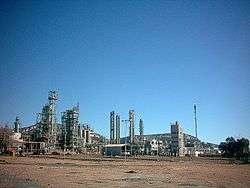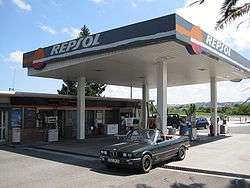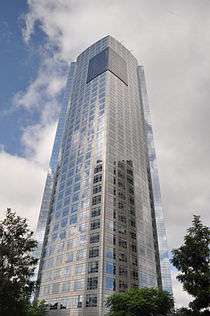Repsol
 | |
_03.jpg) Headquarters (Madrid, Spain) | |
| Sociedad Anónima | |
| Traded as |
BMAD: REP BCBA: REP OTCQX: REPYY |
| Industry | Oil and gas |
| Predecessor | Instituto Nacional de Hidrocarburos |
| Founded | 1987 |
| Headquarters | Repsol Campus, Madrid, Spain |
Area served | Worldwide |
Key people |
Antonio Brufau Niubó (Chairman) Josu Jon Imaz San Miguel (CEO) |
| Products | Oil and gas exploration and production, natural gas and LNG trading and transportation, oil refining, petrochemistry |
| Services | Fuel stations |
| Revenue |
|
| €2.571 billion (2013) | |
| Profit | €195 million (2013) |
| Total assets | €65.086 billion (end 2013) |
| Total equity | €27.920 billion (end 2013) |
Number of employees | 24,214 (end 2013) |
| Subsidiaries | Repsol Petróleo, Repsol Butano, Repsol Química, Repsol Exploración, Petronor |
| Website |
www |


Repsol S.A.[1][nb 1] (Spanish pronunciation: [repˈsol]) is an integrated global energy company based in Madrid, Spain. It carries out upstream and downstream activities throughout the entire world. It has more than 24,000 employees worldwide. It is vertically integrated and operates in all areas of the oil and gas industry, including exploration and production, refining, distribution and marketing, petrochemicals, power generation and trading.
Repsol also partners with Honda Racing Corporation to compete in MotoGP under Repsol Honda Team.
History
Campsa and Repesa
In 1927 CAMPSA (Compañía Arrendataria del Monopolio de Petróleos S.A.), headed by Miguel Primo de Rivera y Orbaneja, was created with the objective of administering concessions in handing over the state monopoly of petroleum companies. Originally the company was arranged so that the state would have a minority stake. The Creation of CAMPSA intensified the progress of the Spanish refinery industry.
In 1941 the Spanish government under Francisco Franco created the INI (National Industry Institute), in order to finance and promote Spanish industries. The INI supported CAMPSA in its exploration of Tudanca, Cantabria, a monumental moment in Spanish exploration on the Iberian Peninsula. The year 1947 marked the end of a 20-year contract between the Spanish state and CAMPSA, decentralizing services while at the same time giving specific rights to the state to intervene in the company’s affairs, minus distribution and commercialization, which remained exclusive to CAMPSA.[2]
In 1948, REPESA (Refinería de Petróleos de Escombreras S.A.) was incorporated for the installation of a refinery in the Valley of Escombreras (Cartagena).
'REPESA became the symbol of the increasing industrial consolidation in the refining sector, as it took on the production and marketing of petrol, oils and lubricants under its own brand name.'[2] From the beginning, REPSOL was REPESA’s "star brand" of petroleum.[2]
The Spanish government created INH in 1981 as a public organisation to integrate the various oil and gas companies in which the Spanish state had a controlling interest. INH created Repsol in October 1987 as a wholly owned subsidiary, bringing together the companies in which the Spanish government had a majority ownership in the areas of exploration and production (formerly Hispanoil), refining (formerly ENPETROL), chemicals and liquefied natural gas (LNG), butane (former Butano S.A.), CAMPSA and Petronor, and Repsol Química (Alcudia).
In 1989, INH partially privatised Repsol, with an IPO of 26% of Repsol capital. Shares of Repsol, S.A. became listed on stock exchanges in Spain and in New York. Privatization was completed in 1997 when the Spanish government sold the remaining 10% of Repsol capital.
Early branding and promotion
In late 1968, REPESA started to develop a prototype team for MotoGP racing and a sponsorship deal. These were the first steps in creating what would one day be known as Repsol Honda. Then in 1971 motor sport was relaunched in Spain and Angel Nieto won the world championship in the 125 cc category sporting the Repsol logo on his bike, as a REPESA product brand.[2]
International expansion
In 1999 Repsol bought 97.81% of the Argentine oil and gas company YPF S.A., which at the time was the largest oil-and-gas company in Latin America. The acquisition better positioned Repsol as a multinational company. Repsol’s acquisition of YPF also increased its capital to 288 million shares worldwide. Repsol's presence in Latin America was one of the keys to corporate growth. It was the first full year after the acquisition of YPF and the consolidation of Gas Natural SDG by global integration. The company's business structure was more balanced and international. Then in December 2001 Repsol completed an asset exchange agreement with Petrobras, making it the second largest consolidated oil company in Brazil. The same year Repsol announced new discoveries in Libya, Indonesia, Spain, Venezuela, Argentina, and Bolivia, prompting the development and marketing of its electricity business through Gas Natural SDG.[2] In 2003 Repsol tripled its reserves and production of hydrocarbons in Trinidad and Tobago. North American expansion in 2008 saw Repsol open a massive regasification plant on the east coast of Canada with enough capacity to supply up to 20% of the gas demand for New York and New England.[2]
Canary Islands
Following years of opposition from environmentalist groups, Spain finally gave permission in August 2014 for the company and its partners to explore prospects off the Canary Islands.[3] Eventually, in January 2015, after two months of exploration about 50 kilometeres off the coasts of Fuerteventura and Lanzarote, the company said in a statement it only found small deposits that were not worth drilling thus scrapping the project.[4]
Change to the company profile
In 2008 Repsol began an intensive exploration campaign in which it focused its efforts on and invested in exploring in new areas, with results that enabled the company to change its profile. Using cutting edge technology, the company made over 30 hydrocarbon discoveries, many of which were considered to be among the largest in the world. This efforts was recognized by Petroleum Economist magazine as the "Best energy company of the year" [5]
Talisman acquisition
In December 2014 Repsol announced that it would buy Canadian oil company Talisman Energy in a transaction worth about $15.1 billion Cdn ($13 billion US).[6]
Company name and origins
In 1971 Repsol logo first appears, as REPESA (Refinería de Petróleos de Escombreras S.A.) brand product, during the motorcycle Derby of that year.
Its name derives from the founding company REPESA for its visibility and easy pronunciation in different languages. In 1991, the Instituto Nacional de Hidrocarbonos (INH), before the imminent demise of the state oil monopoly, set the objective to create a company of mixed public-private capital, which exploded state oil assets. When looking for a name a survey at street level was performed and the only two words that people recognized and associate with the world of oil were CAMPSA (badge of the former monopoly) and REPSOL; obviously, this last one was chosen to name the new company.
"A short, round, sonorous and catchy name was searched. As many terms of the language sink their roots in Latin, here the first letters of a small company of lubricants (Repesa) were used, and the term is completed with the star that identifies Spain in the cultures of the north. Repsol is one of the few names of companies which does not obey an acronym or joins that obsession of putting together letters of horrific names. And that was the first hit"
Business areas
Upstream
Exploration and production of oil and natural gas are in charge of Repsol Exploration SA and its many subsidiaries. It is present in several countries as Spain, Norway, Algeria, Libya, Morocco, Mauritania, Sierra Leone, Liberia, Angola, United States of America, Colombia, Ecuador, Venezuela, Brazil, Peru, Bolivia, Russia and so many others. Repsol’s had an intense exploration campaign throughout these years, with a 38% success rate.
The oil and gas exploration and production activity is Repsol's main growth driver. Repsol has become a world leader in exploration, with over 40 finds since 2008. To guarantee this activity in the long term, in 2013 Repsol incorporated 65 exploration blocks, mainly in the United States (44 blocks) and Norway (6 blocks), into its mining holdings. The 2013 net production reached 346,000 barrels of oil equivalent per day, up pm of 4% compared to 2012.
Downstream
Downstream activity involves the supply and trading of crude and products, oil refining, petroleum product marketing (Marketing), distribution and marketing of Liquefied Petroleum Gas (LPG), production and marketing of chemicals and the development of new energies.
The Repsol Group owns and operates five refineries in Spain (Cartagena, A Coruña, Bilbao, Puertollano and Tarragona), with a combined distillation capacity of 896,000 bo/d. Installed capacity at La Pampilla refinery (Peru), in which Repsol holds a 51.03% stake and is the operator, is 102,000 bo/d.
Marketing their products is in charge of Repsol, CAMPSA and Petronor brand this through an extensive network of over 6,900 outlets, of which over 6,500 are service stations, distributed in Europe and Latin America. Repsol is one of the leading retail distributions of LPG, bottled and bulk, worldwide and is the first in Spain and Latin America. LPG sales totaled 2,464 Mt in 2013.
Chemicals
The Chemicals division produces and markets a wide variety of products in over 90 countries and it is one of the leaders of the market on the Iberian Peninsula. Its activities range from basic petrochemicals to derivatives.
Production is concentrated at three petrochemical complexes located in Spain (Puertollano and Tarragona) and Portugal (Sines), where there is a high level of integration between basic and derivatives, as well as with refining activities in the case of the Spanish facilities. Repsol also has a number of subsidiary and affiliate companies, through which the company produces polypropylene compounds, chemical specialties and synthetic rubber at special plants.
Electricity and gas
Repsol has 30% stake in Gas Natural Fenosa, which carry on the activities of gas and electricity distribution. In Spain, this business includes the compensated gas distribution activity, TPA (third-party network access services) and secondary transport, as well as non-compensated distribution activities. Sales from the regulated gas business in Spain amounted to 191,189 GWh in 2013, down 2.3% on the prior year. The distribution business now boasts 455,000 supply points, representing an increase of 1.3% over the previous year. Electricity supply points in Spain kept steady with 2012 levels, at 3,772,000. Electricity effectively supplied decreased 3% from 2012 to 2013, to 32,766 GWh, mainly because of more clement weather conditions.
Brief chronology
- 1948 incorporation REPESA (Refinería de Petróleos de Escombreras S.A.) created for the installation of a refinery in the Valley of Escombreras, Cartagena (Spain).
- 1981 Creation of INH: Public organization created to integrate the various companies operating in the oil and gas in which the Spanish state had a controlling interest or was the sole owner.
- 1987 Creation of the Repsol group: Its sole shareholder is the INH. Repsol brings together the companies in which the Spanish state had a controlling interest in the areas of exploration and production (old Hispanoil), refining (formerly ENPETROL), chemical and liquefied natural gas (LNG), Butane (former Butano S.A.), CAMPSA and Petronor. Repsol Chemical (Alcudia), initially a subsidiary of Repsol Petroleum, which will then be a subsidiary.
- 1989 The State (INH) began the privatization of Repsol. IPO of 26% of Repsol Capital. Repsol shares, S.A. upgraded trading on exchanges in Spain and New York.
- 1991 Natural Gas Company is created.
- 1997 The State completes the process of privatization of Repsol. IPO of 10% of Repsol capital
- 1997 Repsol buys shares of the Argentinian company Astra, founded in 1912 and belonging to the family Grunensein.
- 1998 Repsol studies the possibility of come to the privatization of YPF.
- 1999 Acquisition of YPF (ex Yacimientos Petrolíferos Fiscales) by Repsol.
- 2007 Purchase of 14.9% by the Petersen Group, an Argentinian company controlled by Enrique Eskenazi.
- In November 2008 LUKoil was interested in acquiring about 30% of the shares of Repsol (20% owned by Sacyr and 10% of Caja Madrid).
- On April 16, 2012 the President of Argentina, Cristina Fernandez de Kirchner announced the introduction in the Congress of a bill to "safeguard the sovereignty of Argentina hydrocarbons." This project has as main purpose the expropriation of 51% of the shares of YPF.
- On March 28 Repsol’s Annual General Meeting ratified the "Convenio de Solución Amigable y Avenimiento de Expropiación" which recognises the Repsol’s right to receive $5 billion as compensation for the expropriation of the 51% shareholding in YPF and YPF GAS, together with payment guarantees.
Expropriation of YPF

In May 2012, the Argentine president Cristina Fernández de Kirchner, presented a project before the government to expropriate 51% of Repsol’s shares of YPF. The Republic of Argentina's Yacimientos Petrolíferos Fiscales Act that was passed that summer officially made possible the expropriation of Repsol's Shares. Repsol went to various international entities to pursue legal action directly after losing its shares of YPF.[2] The expropriation was an attempt by the Argentine government to nationalize its oil and gas production. Results however show that the move to nationalize actually hurt oil production in Argentina. Compared to the oil production in 2011, YPF’s oil production in 2012 fell by 8%, according to data from Argentina’s Department of Energy.[7]
Repsol has the backing of the EU and the US, as both powers condemned Argentina’s move at expropriation. President Fernández claimed that the state would seize 51% of YPF.[8] In June 2013, Repsol rejected a $5 billion proposal from Argentina to compensate for the 2012 expropriation. The proposal also would have given Repsol drilling rights to 6.4% of the massive Vaca Muerta shale-gas field. The board of the Repsol firm unanimously rejected this offer, as it would have caused them to drop a $10.5 billion lawsuit that was in progress against the Argentine government. Repsol at the time owned 6.4% of YPF oil-and-gas company.[9] On 25 February 2014 the Repsol board announced it had accepted a settlement offer from the Argentine government of an issue of Argentine bonds valued at $5 billion. The deal concluded after 3 months of negotiations in Buenos Aires was subject to shareholder approval. The agreement ended two years of legal wrangling and the potential for a long drawn-out legal battle. Repsol Chairman Antonio Brufau described the "friendly" settlement as "extremely positive." [10]
Environmental record
In 2011 Repsol built the world's first service station certified by BREEAM, "the leading international method for evaluating and certifying building sustainability". The construction of the station was completed under green architecture parameters, utilizing multiple recycled materials.[2] The publication Newsweek selected Repsol as the most environmentally respectful energy company of 2012.[11] However, recent reports of Repsol drilling in the indigenous lands of the Peruvian Amazon display a disregard for the environment. According to an Environmental Impact Assessment, Repsol’s exploration of the rainforest will involve drilling at least 21 wells. Although Repsol denies it, 20 of the 21 wells fall within the land of indigenous people, who are very vulnerable to any sort of contact with foreigners.[12]
See also
References
- ↑ "Repsol cambia el nombre tras expropiación en Argentina", El Nuevo Herald, 2012-05-31
- 1 2 3 4 5 6 7 8 "Repsol.com About us>Our History".
- ↑ "Spain's Repsol gets long awaited green signal to explore off Canary Islands". Spain News.Net. 13 August 2014. Retrieved 13 August 2014.
- ↑ Repsol scraps controversial oil exploration off Canary Islands The Guardian 19 January 2015
- ↑ "UPI.com Business News>Energy Resource".
- ↑ "cbc.ca Business News>Talisman agrees to $15.1B Cdn takeover by Spain's Repsol".
- ↑ "Repsol expropriation: So who is eating Argentina's lunch now?".
- ↑ "US Condemns YPF Expropriation As Spain-Argentina Trade War Nears".
- ↑ "Repsol Rejects Argentina's YPF Compensation Offer".
- ↑ "$5bn compensation by Argentina for YPF assets accepted by Repsol". Argentina Star. Retrieved 26 February 2014.
- ↑ "Repsol, elegida la energética más respetuosa con el medio ambiente por Newsweek".
- ↑ "Repsol to drill for oil in Amazon rainforest in Peru".
Notes
- ↑ Originally an initialism for Refinería de Petróleos de Escombreras adding the word Sol (Sun)
External links
![]() Media related to Repsol at Wikimedia Commons
Media related to Repsol at Wikimedia Commons
- Official website
- Repsol companies grouped at OpenCorporates